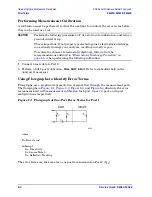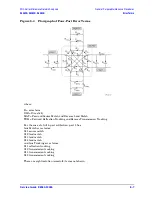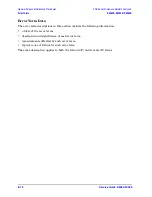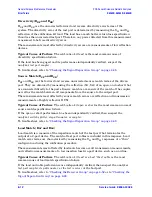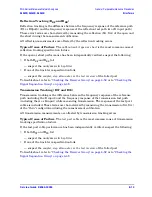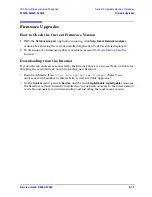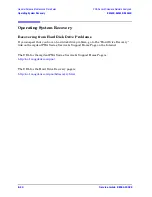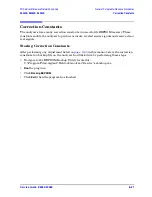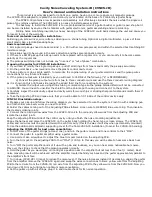
8-12
Service Guide E8364-90026
General Purpose Maintenance Procedures
PNA Series Microwave Network Analyzers
Error Terms
E8362B, E8363B, E8364B
Directivity (E
DF
and E
DR
)
E
DF
and E
DR
are the uncorrected forward and reverse directivity error terms of the
system. The directivity error of the test port is determined by measuring the S
11
and S
22
reflection of the calibration kit load. The load has a much better return loss specification
than does the uncorrected test port. Therefore, any power detected from this measurement
is assumed to be from directivity error.
The measurements most affected by directivity errors are measurements of low reflection
devices.
Typical Cause of Failure
The
calibration kit load
is the most common cause of
directivity specification failure.
If the load has been gaged and its performance independently verified, suspect the
analyzer
test port coupler
.
To troubleshoot, refer to
“Checking the Signal Separation Group” on page 4-48
.
Source Match (E
SF
and E
SR
)
E
SF
and E
SR
are the forward and reverse uncorrected source match terms of the driven
port. They are obtained by measuring the reflection (S
11
, S
22
) of an open, and a short that
are connected directly to the ports. Source match is a measure of the match of the coupler,
as well as the match between all components from the source to the output port.
The measurements most affected by source match errors are reflection and transmission
measurements of highly reflective DUTs.
Typical Cause of Failure
The
calibration kit open or shor
t is the most common cause of
source match specification failure.
If the open or short performance has been independently verified, then suspect the
analyzer
switch splitter, step attenuator, or coupler
.
To troubleshoot, refer to
“Checking the Signal Separation Group” on page 4-48
.
Load Match (E
LF
and E
LR
)
Load match is a measure of the impedance match of the test port that terminates the
output of a 2-port device. The match of test port cables is included in this response. Load
match error terms are characterized by measuring the S
11
and S
22
responses of a “thru”
configuration during the calibration procedure.
The measurements most affected by load match errors are all transmission measurements,
and reflection measurements of a low insertion loss two-port device, such as an airline.
Typical Cause of Failure
The
calibration kit load or a bad “thru” cable
is the most
common cause of load match specification failure.
If the load and cable performance are independently verified, then suspect the analyzer
test port coupler, step attenuator, or the test receiver
at the bad port.
To troubleshoot, refer to
“Checking the Receiver Group” on page 4-52
or to
Summary of Contents for E8362B
Page 11: ...Service Guide E8364 90026 1 1 1 Safety and Regulatory Information ...
Page 19: ...Service Guide E8364 90026 2 1 2 General Product Information ...
Page 33: ...Service Guide E8364 90026 3 1 3 Tests and Adjustments ...
Page 83: ...Service Guide E8364 90026 4 1 4 Troubleshooting ...
Page 151: ...Service Guide E8364 90026 5 1 5 Theory of Operation ...
Page 185: ...Service Guide E8364 90026 6 1 6 Replaceable Parts ...
Page 269: ...Service Guide E8364 90026 7 1 7 Repair and Replacement Procedures ...
Page 351: ...Service Guide E8364 90026 8 1 8 General Purpose Maintenance Procedures ...







